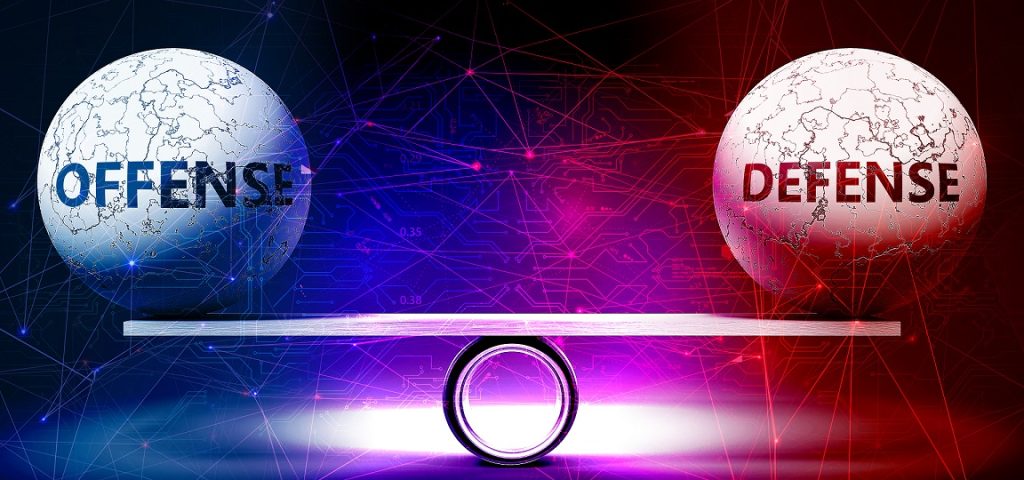
YIN AND YANG: The yin and yang depict two opposite but interconnected, mutually perpetuating forces: One is unsustainable without the other. (Image by Peterschreiber.Media via Adobe Stock)
PEO IEW&S incorporated new project management offices to better support cyber capabilities.
by Megan Paice
The U.S. Army recognizes that the areas of cyber, space and electronic warfare are three keywords that have a continuous need to scale yet work in synergy. To support the demand of these capabilities, both offensively and defensively, the Army recently restructured within Program Executive Office Intelligence, Electronic Warfare and Sensors (PEO IEW&S) to streamline its enterprise of network and cyber operations. PEO IEW&S reorganized with the incorporation of two new project management offices: Project Manager Cyber and Space (PM C&S) and Project Manager Defensive Cyber Operations (PM DCO). Missions also shifted within the Project Manager Electronic Warfare and Cyber (PM EW&C).
This reorganization assists in fostering an environment that enables Army and joint offensive cyber operations to further develop in a more cohesive environment. Offensive cyber acquisition materiel development requires the same focused leadership structures as our acquisition requirements in electronic warfare (PM EW&C) or defensive cyber operations (PM DCO). A good example of this is the yin and yang, which depicts two opposite but interconnected, mutually perpetuating forces—one is unsustainable without the other.
“The Army needs to balance offensive and defensive cyberspace capabilities in support of operational forces—offense informs defense and defense informs offense. One program executive office for both portfolios improves visibility and supports flexibility to equip our forces according to a rapidly changing operational environment. Furthermore, one PEO improves the Cyber Center of Excellence’s ability to develop education and training required for new capabilities,” said Maj. Gen. Paul T. Stanton, Cyber Center of Excellence commanding general.
CREATION OF PM C&S
The establishment of PM Cyber and Space allows for more dedicated support to the Army cyber community. The core mission at PM C&S is to acquire and field offensive cyber and tactical space capabilities to protect the Soldier, the nation and enable cyberspace superiority.
However, it’s important to note that it is crucial for the Army to recognize these contributions to the joint cyber warfighting operations go further than Army Cyber Command but, also, span throughout the entire Army acquisition community.
Initially, PM C&S will be comprised of Product Manager Information Warfare Cyber and Product Manager Information Warfare Cyber Infrastructure development. This realignment includes the migration of various tools, including the Rapid Cyber Development Network—a remote accessible closed network supported by commercial-off-the-shelf (COTS) hardware and COTS/open-source software—to drive cyber capabilities development and testing for DOD equities and Joint Common Access Platform (JCAP), which supports U.S. Cyber Command by providing a protected, managed, orchestrated environment and common firing platform to coordinate and execute the delivery of cyber effects against approved targets. JCAP enables the cyber mission forces’ ability to execute operations while managing detection and attribution.
“The days of the Army being a kinetic-only force are gone,” said Brig. Gen. Wayne ‘Ed’ Barker, program executive officer for IEW&S. “Our ability to operate in multiple arenas has become paramount with none more important than mastering the cyber warfare arena…The speed in which you must operate in this environment [cyberspace] is crucial. That’s why we felt the emphasis on this domain is important enough to stand-up a dedicated organization. An organization with the agility, the mechanisms, the processes in place, the workforce, the culture to be able to respond quickly to threats.”

BALANCING ACT
A synergy and balance naturally occur between successful offensive and defensive cyber, space and electronic warfare tactics. (Graphic by PEO IEW&S)
THE TRANSITION
PM DCO transitioned to PEO IEW&S from PEO Enterprise Information Systems at the start of fiscal year 2024, on October 1. The transition occurred during a critical time because the digital landscape continues to rapidly evolve.
“The Army must contend with the constant evolution of advanced persistent threats, thus requiring the U.S. Army to remain vigilant and adaptive. DCO will continue to provide information dominance and decisive lethality with platforms and systems critical to defending the Department of Defense networks,” said Robert J. Zoppa, project manager for DCO.
With information dominance and decisive lethality, DCO analyzes data, monitors and detects insider threats, identifies malware and counters cyber-attacks. The threats posed by adversaries in cyberspace are diverse and constantly evolving, requiring the Army to remain vigilant and adaptive.
The primary focus within DCO within the next year is to align with U.S. Army Cyber Command priorities, starting with accreditation. This includes a complete Risk Management Framework 2.0 continued package for use on DCO Suite of Complimentary Systems and continued authorization to operate on Department of Defense Information Network through U.S. Army Network Enterprise Technology Command.
A LOOK AT PM DCO
The Cyber Platforms and Systems (CPS) provides total life cycle management capability to the force. CPS focuses on the procurement and delivery of cyber platforms and cybersecurity tools for the armed forces. The Defensive Cyberspace Operations Tools Suite is the foundational piece of equipment used by cyber-Soldiers. These tools are used to effectively conduct cyber protection team missions.
The Cyber Analytics and Detection (CAD) provides capabilities that help Soldiers analyze and detect external and internal cyber threats to the Army. CAD focuses on software-based programs that support mission command, planning, integration, analysis and execution at all levels.
INTERNAL MOVEMENT
Another portion of the portfolio within PEO IEW&S is Project Manager Electronic Warfare & Cyber. The PM EW&C mission is to acquire and field integrated electronic warfare, intelligence and cyber capabilities to enable spectrum and cyberspace superiority to support an Army equipped with upgradable, integrated and networked electronic warfare, signal intelligence (SIGINT), cyber capabilities to overmatch the threat in multi- and joint all-domain operations.
From this mission set, the Terrestrial Layer System (TLS) family of systems was developed.
TLS is a family of systems all supporting SIGINT, cyber and electronic warfare operations but each covers a slightly different piece of the battlespace. TLS Echelons Above Brigade is planned for mission command above the brigade level and will sit furthest from forward line of own troops. TLS Brigade Combat Team (TLS BCT), moves with the force and is planned for use with maneuver units, helping extend the range of sensing. TLS BCT Manpack extends sensing even further because it can be worn by Soldiers accessing more remote or vehicle-prohibitive terrain. Together, the TLS family of systems provides the deep sensing capability the Army needs in multidomain operations.
CONCLUSION
“We’re already aware that the battlefield has long surpassed land, sea, and air with space and cyberspace,” said Young J. Bang, principal deputy assistant secretary of the Army for acquisition, logistics and technology, when asked how synergy strengthens the future of the warfighter and DOD. “But with exponential growth in technology, these fields continue to evolve just as quickly. The strength in our forces is defined by the combination of our physical and digital warfare capabilities. As we see from the ongoing conflict in Ukraine, enhancing survivability in a contested cyberspace is just as critical to conducting successful operations across every domain. This reorganization is a wise investment in the Army’s future.”
New challenges and innovative solutions are needed at a time where having an active digital footprint is considered the ‘norm’. Continuous advancement in the growing and constantly evolving focus areas of electronic warfare, SIGINT and cyberspace will help ensure that our Soldiers exceed overmatch. Under the same PEO, information can now be shared seamlessly amongst team members to optimize the synergy needed to support the wide-ranging cyber warfare needs of the Army to prevent potential cyber vulnerabilities.
For more information go to, https://peoiews.army.mil.
MEGAN PAICE is a public affairs specialist with Program Executive Office Intelligence, Electronic Warfare and Sensors. She has a B.S. in Communications from Towson University. Prior to joining the PEO, she worked as a public affairs analyst in research and development.


